1000+ Animal Kingdom Multiple Choice Question Answer [Solved]
Thursday 9th of March 2023

Sharing is caring
1. Which of the following possesses electric organs and belongs to class chondrichthyes?
A. Torpedo
B. Petromyzon
C. Trygon
D. Exocoetus
Answer : A
A. Torpedo
B. Petromyzon
C. Trygon
D. Exocoetus
Answer : A
2. In amphibians, heart is ________ chambered.
A. two
B. three
C. four
D. none of these
Answer : B
A. two
B. three
C. four
D. none of these
Answer : B
3. Which of the following statements (i – v) are incorrect ?
A. (i) only
B. (iii) only
C. (i) and (iii)
D. (iii) and (iv)
Answer : A
- Circulatory system in arthropods is of closed type.
- Parapodia in annelids helps in swimming.
- Phylum mollusca is the second largest animal phylum.
- Aschelminthes are dioecious.
A. (i) only
B. (iii) only
C. (i) and (iii)
D. (iii) and (iv)
Answer : A
4. A common characteristic of all vertebrates without exception is
A. the division of body into head, neck, trunk and tail.
B. body covered with exoskeleton.
C. the possession of two pairs of functional appendages.
D. the presence of well- developed skull.
Answer : D
A. the division of body into head, neck, trunk and tail.
B. body covered with exoskeleton.
C. the possession of two pairs of functional appendages.
D. the presence of well- developed skull.
Answer : D
5. Refer the types of cells present in some animals. Each cell is specialized to perform a single specific function except
A. Cnidocytes
B. Choanocytes
C. Interstitial cells
D. Gastrodermal cells
Answer : C
A. Cnidocytes
B. Choanocytes
C. Interstitial cells
D. Gastrodermal cells
Answer : C
6. Which of the following animal contains respiratory organs like, gills, book gills, book lungs or tracheal system?
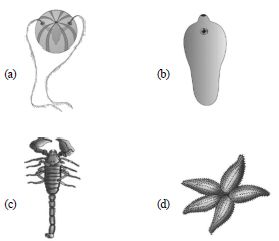
A. Click to check answer
B. Click to check answer
C. Click to check answer
D. Click to check answer
Answer : C

A. Click to check answer
B. Click to check answer
C. Click to check answer
D. Click to check answer
Answer : C
7. Which of the following statements (i v) are incorrect?
(i) Parapodia are lateral appendages in arthropods used for swimming.
(ii) Radula in molluscs are structures involved in excretion.
(iii) Aschelminthes are dioecious.
(iv) Echinoderm adults show radial symmetry.
(v) Ctenophorans are diploblastic.
A. (i) and (ii)
B. (i) and (iii)
C. (i), (iv) and (v)
D. (iii) and (v)
Answer : A
(i) Parapodia are lateral appendages in arthropods used for swimming.
(ii) Radula in molluscs are structures involved in excretion.
(iii) Aschelminthes are dioecious.
(iv) Echinoderm adults show radial symmetry.
(v) Ctenophorans are diploblastic.
A. (i) and (ii)
B. (i) and (iii)
C. (i), (iv) and (v)
D. (iii) and (v)
Answer : A
8. Refer the figures A, B and C and choose the correct option which shows animals that regulate buoyancy with the help of air bladder.
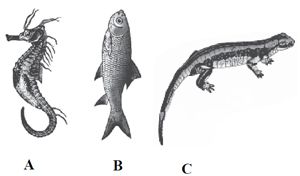
A. A and B
B. A and C
C. B and C
D. All of the above.
Answer : A

A. A and B
B. A and C
C. B and C
D. All of the above.
Answer : A
9. Which of the following possesses poison sting and belongs to class chondrichthyes?
A. Labeo
B. Myxine
C. Clarias
D. Trygon
Answer : D
A. Labeo
B. Myxine
C. Clarias
D. Trygon
Answer : D
10. Which of the following pairs of animals comprises jawless fishes?
A. Mackerals and rohu
B. Lampreys and hag fishes
C. Guppies and hag fishes
D. Lampreys and eels
Answer : B
A. Mackerals and rohu
B. Lampreys and hag fishes
C. Guppies and hag fishes
D. Lampreys and eels
Answer : B
11. The figure given below shows the germinal layers marked as A, B, C and D. Identify the label showing undifferentiated layer and its location?
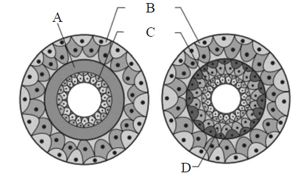
A. A, Between B & C
B. B, Between A & C
C. C, Between C & D
D. D, Between A & B
Answer : A

A. A, Between B & C
B. B, Between A & C
C. C, Between C & D
D. D, Between A & B
Answer : A
12. The given figure shows some characteristic features marked as chordates. Identify the correct labelling A,B,C and D.
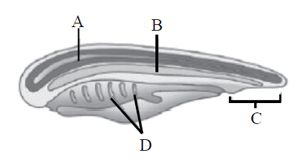
A. A-Notochord; B-Post-anal part; C-Gill slits; D-Nerve cord
B. A-Nerve cord; B-Notochord; C-Post-anal part; D-Gill slits
C. A-Notochord; B-Nerve cord; C-Gill slits; D-Post-anal part
D. A-Gill slits; B-Post-anal part; C-Nerve cord; D-Notochord
Answer : B

A. A-Notochord; B-Post-anal part; C-Gill slits; D-Nerve cord
B. A-Nerve cord; B-Notochord; C-Post-anal part; D-Gill slits
C. A-Notochord; B-Nerve cord; C-Gill slits; D-Post-anal part
D. A-Gill slits; B-Post-anal part; C-Nerve cord; D-Notochord
Answer : B
13. Which of the following traits is not shared by both sea anemones and jellyfish ?
A. A medusa as the dominant stage in the life cycle.
B. Possession of a gastro vascular cavity.
C. Sexual reproduction.
D. Nematocysts present on the tentacles.
Answer : A
A. A medusa as the dominant stage in the life cycle.
B. Possession of a gastro vascular cavity.
C. Sexual reproduction.
D. Nematocysts present on the tentacles.
Answer : A
14. Which of the following statement(s) is/are correct regarding class aves?
(i) The forelimbs are modified into wings and the hindlimbs generally have scales and are modified for walking, swimming or clasping the tree branches.
(ii) Heart is completely four-chambered.
(iii) They are warm- blooded (homoiothermous) animals i.e., they are able to maintain a constant body temperature.
(iv) They are oviparous and development is direct.
A. Both (i) and (iii)
B. Both (i) and (iv)
C. (i), (ii) and (iii)
D. All of these
Answer : D
(i) The forelimbs are modified into wings and the hindlimbs generally have scales and are modified for walking, swimming or clasping the tree branches.
(ii) Heart is completely four-chambered.
(iii) They are warm- blooded (homoiothermous) animals i.e., they are able to maintain a constant body temperature.
(iv) They are oviparous and development is direct.
A. Both (i) and (iii)
B. Both (i) and (iv)
C. (i), (ii) and (iii)
D. All of these
Answer : D
15. Meandrina (brain coral) belongs to phylum
A. porifera
B. coelenterata
C. ctenophora
D. platyhelminthes
Answer : B
A. porifera
B. coelenterata
C. ctenophora
D. platyhelminthes
Answer : B
16. Which of the following statement(s) is/are correct regarding phylum coelenterata?
(i) They are aquatic, mostly marine, sessile or freeswimming, radially symmetrical animals.
(ii) They have a central gastro-vascular cavity with a single opening called hypostome.
(iii) Digestion is extracellular and intracellular.
(iv) Examples are Sycon, Spongilla and Euspongia.
A. (i) and (ii)
B. (i) and (iv)
C. (i), (ii) and (iii)
D. All of these
Answer : C
(i) They are aquatic, mostly marine, sessile or freeswimming, radially symmetrical animals.
(ii) They have a central gastro-vascular cavity with a single opening called hypostome.
(iii) Digestion is extracellular and intracellular.
(iv) Examples are Sycon, Spongilla and Euspongia.
A. (i) and (ii)
B. (i) and (iv)
C. (i), (ii) and (iii)
D. All of these
Answer : C
17. Which of the following is a correct match of a phylum with their three examples?
A. PlatyhelminthesPlanaria, Schistosoma, Enterobius
B. Mollusca Loligo, Sepia, Octopus
C. Porifera Spongilla, Euplectella, Pennatula
D. Cnidaria Bonellia, Physalia, Aurelia
Answer : B
A. PlatyhelminthesPlanaria, Schistosoma, Enterobius
B. Mollusca Loligo, Sepia, Octopus
C. Porifera Spongilla, Euplectella, Pennatula
D. Cnidaria Bonellia, Physalia, Aurelia
Answer : B
18. Refer the figures A, B, C and D given below. Which of the following options shows the correct name of the animals shown by the figures A, B, C and D ?

A. A – Locust, B – Scorpion, C – Prawn, D – Pila
B. A – Locust, B – Prawn, C – Scorpion, D – Pila
C. A – Locust, B – Scorpion, C – Prawn, D – Snail
D. A – Butterfly, B – Scorpion, C – Prawn, D – Pila
Answer : A

A. A – Locust, B – Scorpion, C – Prawn, D – Pila
B. A – Locust, B – Prawn, C – Scorpion, D – Pila
C. A – Locust, B – Scorpion, C – Prawn, D – Snail
D. A – Butterfly, B – Scorpion, C – Prawn, D – Pila
Answer : A
19. Identify the correct characteristics of porifera.
A. (ii), (v) only
B. (i), (ii), (vi) only
C. (i), (ii), (iii), (iv) only
D. All of these.
Answer : A
- Commonly known as sea walnuts.
- Presence of ostia and collar cells.
- Exhibit tissue level of characteristics.
- It is the largest phylum of animal kingdom.
- The body is supported by spicules and sponging fibers.
- Contains cnidocytes which is used for defense, anchorage and capturing of prey.
A. (ii), (v) only
B. (i), (ii), (vi) only
C. (i), (ii), (iii), (iv) only
D. All of these.
Answer : A
20. Which of the following sets of animals give birth to young ones?
A. Platypus, Penguin, Bat, Hippopotamus.
B. Shrew, Bat, Cat, Kiwi.
C. Kangaroo, Hedgehog, Dolphin, Loris.
D. Lion, Bat, Whale, Ostrich.
Answer : C
A. Platypus, Penguin, Bat, Hippopotamus.
B. Shrew, Bat, Cat, Kiwi.
C. Kangaroo, Hedgehog, Dolphin, Loris.
D. Lion, Bat, Whale, Ostrich.
Answer : C
21. Identify the figures and select the correct option
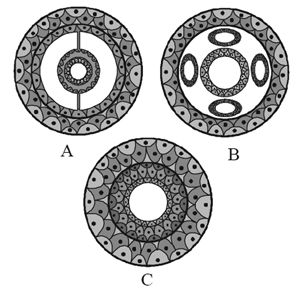
A. A - Pseudocoelomate; B - Coelomate, C-Acoelomate
B. A - Coelomate, B - Pseudocoelomate, C- Acoelomate
C. A - Coelomate; B- Acoelomate; C - Pseudocoelomate
D. A - Coelomate; B- Acoelomate; C-Eucoelomate
Answer : B

A. A - Pseudocoelomate; B - Coelomate, C-Acoelomate
B. A - Coelomate, B - Pseudocoelomate, C- Acoelomate
C. A - Coelomate; B- Acoelomate; C - Pseudocoelomate
D. A - Coelomate; B- Acoelomate; C-Eucoelomate
Answer : B
22. The transition from aquatic to terrestrial lifestyles required many adaptations in the vertebrate lineage. Which of the following is not one of those adaptations ?
A. Switch from gill respiration to air-breathing lungs.
B. Improvements in water resistance of skin.
C. Alteration in mode of locomotion.
D. Development of feathers for insulation.
Answer : D
A. Switch from gill respiration to air-breathing lungs.
B. Improvements in water resistance of skin.
C. Alteration in mode of locomotion.
D. Development of feathers for insulation.
Answer : D
23. Identify the figure with its correct name and phylum.

A. Cucumaria – Echinodermata
B. Ascidia – Urochordata
C. Balanoglossus – Hemichordata
D. Hirudinaria – Annelida
Answer : C

A. Cucumaria – Echinodermata
B. Ascidia – Urochordata
C. Balanoglossus – Hemichordata
D. Hirudinaria – Annelida
Answer : C
24. Which of the following animal's body is covered by calcareous shell and unsegmented with a distinct head, muscular foot, and visceral hump?
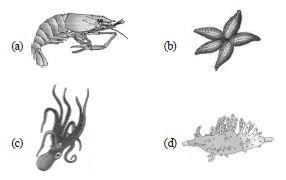
A. Click to check answer
B. Click to check answer
C. Click to check answer
D. Click to check answer
Answer : C

A. Click to check answer
B. Click to check answer
C. Click to check answer
D. Click to check answer
Answer : C
25. Which one of the following statement regarding coelom of given animals is correct?
A. Round worms (aschelminthes) are pseudocoelomates.
B. Molluscs are acoelomates.
C. Insects are pseudocoelomates.
D. Flatworms (platyhelminthes) are coelomates.
Answer : A
A. Round worms (aschelminthes) are pseudocoelomates.
B. Molluscs are acoelomates.
C. Insects are pseudocoelomates.
D. Flatworms (platyhelminthes) are coelomates.
Answer : A
26. Which of the following statement(s) is/are correct for class amphibia?
(i) Body is divisible into head and trunk.
(ii) Respiration is through gills only.
(iii) The heart is two chambered i.e. one auricle and one ventricle.
(iv) Fertilization is internal.
A. Only (i)
B. Only (iv)
C. (i), (ii) and (iii)
D. All of these
Answer : A
(i) Body is divisible into head and trunk.
(ii) Respiration is through gills only.
(iii) The heart is two chambered i.e. one auricle and one ventricle.
(iv) Fertilization is internal.
A. Only (i)
B. Only (iv)
C. (i), (ii) and (iii)
D. All of these
Answer : A
27. Which of the following class is being described by the given statements (i - iv)?
(i) They are found in a variety of habitats- polar ice-caps, deserts, mountains, forests, grasslands and dark caves.
(ii) Most unique mammalian characteristic is the presence of mammary glands by which the young ones are nourished.
(iii) Heart is four-chambered.
(iv) Sexes are separate and fertilization is internal.
A. Reptilia
B. Aves
C. Mammalia
D. Amphibia
Answer : C
(i) They are found in a variety of habitats- polar ice-caps, deserts, mountains, forests, grasslands and dark caves.
(ii) Most unique mammalian characteristic is the presence of mammary glands by which the young ones are nourished.
(iii) Heart is four-chambered.
(iv) Sexes are separate and fertilization is internal.
A. Reptilia
B. Aves
C. Mammalia
D. Amphibia
Answer : C
28. Match the organisms given in column-I with their common name given in column-II and choose the correct option.
A. A II; C III; D I; E IV
B. A II; C IV; D I; E III
C. A II; C I; D III; E IV
D. A II; C I; D III; E IV
Answer : C
| Column -I | Column -II |
|---|---|
| (Organisms) | (Comman name) |
| A. Pennatula | I. Sea-lily |
| B. Antedon | II. Sea- pen |
| C. Echinus | III. Sea-urchin |
| D. Cucumaria | IV. Sea - cucumber |
A. A II; C III; D I; E IV
B. A II; C IV; D I; E III
C. A II; C I; D III; E IV
D. A II; C I; D III; E IV
Answer : C
29. Which of the following statement(s) is/are correct?
(i) Animals in which the cells are arranged in two embryonic layers, an external ectoderm and an internal endoderm, are called diploblastic animals.
(ii) Notochord is an ectodermally derived rod like structure formed on the ventral side during embryonic development in some animals.
(iii) In some animals, the body cavity is not lined by mesoderm, instead, the mesoderm is present as scattered pouches in between the ectoderm and endoderm and such a body cavity is called pseudocoelom.
A. Only (i)
B. Both (i) and (ii)
C. Both (i) and (iii)
D. All of these
Answer : C
(i) Animals in which the cells are arranged in two embryonic layers, an external ectoderm and an internal endoderm, are called diploblastic animals.
(ii) Notochord is an ectodermally derived rod like structure formed on the ventral side during embryonic development in some animals.
(iii) In some animals, the body cavity is not lined by mesoderm, instead, the mesoderm is present as scattered pouches in between the ectoderm and endoderm and such a body cavity is called pseudocoelom.
A. Only (i)
B. Both (i) and (ii)
C. Both (i) and (iii)
D. All of these
Answer : C
30. Which one of the following features is common in silverfish, scorpion, dragonfly and prawn?
A. Three pairs of legs and segmented body.
B. Chitinous cuticle and two pairs of antennae.
C. Jointed appendages and chitinous exoskeleton.
D. Cephalothorax and tracheae.
Answer : C
A. Three pairs of legs and segmented body.
B. Chitinous cuticle and two pairs of antennae.
C. Jointed appendages and chitinous exoskeleton.
D. Cephalothorax and tracheae.
Answer : C
31. Column I contains zoological names of animals and column II contains their common name. Match the following and choose the correct option.
A. A III; B II; C I; D IV
B. A IV; B III; C II; D I
C. A IV; B II; C III; D I
D. A II; B III; C I; D IV
Answer : C
| Column -I | Column- II |
|---|---|
| A. Physalia | I. Sea anemone |
| B. Meandrina | II. Brain coral |
| C. Gorgonia | III. Sea fan |
| D. Adamsia | IV. Portuguese man-of-war |
A. A III; B II; C I; D IV
B. A IV; B III; C II; D I
C. A IV; B II; C III; D I
D. A II; B III; C I; D IV
Answer : C
32. Refer the given figures A, B, C and D and identify the option which shows their correct name.
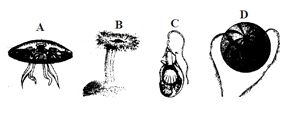
A. A - Pleurobrachia, B - Cnidoblast, C - Aurelia, D - Adamsia
B. A - Aurelia, B - Adamsia, C - Cnidoblast, D - Pleurobrachia
C. A - Cnidoblast, B - Pleurobrachia, C - Adamsia, D - Aurelia
D. A - Adamsia, B - Aurelia, C - Pleurobrachia, D - Cnidoblast
Answer : B

A. A - Pleurobrachia, B - Cnidoblast, C - Aurelia, D - Adamsia
B. A - Aurelia, B - Adamsia, C - Cnidoblast, D - Pleurobrachia
C. A - Cnidoblast, B - Pleurobrachia, C - Adamsia, D - Aurelia
D. A - Adamsia, B - Aurelia, C - Pleurobrachia, D - Cnidoblast
Answer : B
33. Identify the correct characteristic feature shown by the given figure?

A. Diploblastic in nature.
B. Having radial symmetrical body.
C. Dioecious with direct development.
D. Presence of sensory tentacles on anterior head region.
Answer : D

A. Diploblastic in nature.
B. Having radial symmetrical body.
C. Dioecious with direct development.
D. Presence of sensory tentacles on anterior head region.
Answer : D
34. Which of the following statements is without exception in sponges ?
A. They all have calcareous spicules.
B. They have high regenerative power.
C. They are found only in marine water.
D. They are all radially symmetrical.
Answer : B
A. They all have calcareous spicules.
B. They have high regenerative power.
C. They are found only in marine water.
D. They are all radially symmetrical.
Answer : B
35. Which of the following feature is not correct regarding the figure given below?

A. It is an aquatic form.
B. Circulatory system is of open type.
C. It possesses parapodia for swimming.
D. Neural system consists of paired ganglia connected by lateral nerves to a double ventral nerve cord.
Answer : B

A. It is an aquatic form.
B. Circulatory system is of open type.
C. It possesses parapodia for swimming.
D. Neural system consists of paired ganglia connected by lateral nerves to a double ventral nerve cord.
Answer : B
36. Which of the following group of animals belongs to the same phylum?
A. Earthworm, pinworm, tapeworm
B. Prawn, scorpion, Locusta
C. Sponge, Sea anemone, starfish
D. Malarial parasite, Amoeba, mosquito
Answer : B
A. Earthworm, pinworm, tapeworm
B. Prawn, scorpion, Locusta
C. Sponge, Sea anemone, starfish
D. Malarial parasite, Amoeba, mosquito
Answer : B
37. In amphibians, respiration occurs through
A. gills
B. lungs
C. skin
D. all of these
Answer : D
A. gills
B. lungs
C. skin
D. all of these
Answer : D
38. Which of the following characteristic distinguish arthropoda from annelids and molluscs ?
A. An external skeleton made of chitin (a polysaccharide) and protein rather than a shell made chiefly of mineral salts.
B. Subdivision of the legs into movable segments.
C. Distinct group of muscles, derived from many body segments, that move the separate parts of the exoskeleton.
D. All of the above
Answer : D
A. An external skeleton made of chitin (a polysaccharide) and protein rather than a shell made chiefly of mineral salts.
B. Subdivision of the legs into movable segments.
C. Distinct group of muscles, derived from many body segments, that move the separate parts of the exoskeleton.
D. All of the above
Answer : D
39. Which one of the following categories of animals is correctly described with no single exception in it?
A. In chondrichthyes notochord is persistent throughout life.
B. All mammals are viviparous and possess diaphragm for breathing.
C. All sponges are marine.
D. All reptiles possess scales, have a three chambered heart and are cold blooded (poikilothermal).
Answer : A
A. In chondrichthyes notochord is persistent throughout life.
B. All mammals are viviparous and possess diaphragm for breathing.
C. All sponges are marine.
D. All reptiles possess scales, have a three chambered heart and are cold blooded (poikilothermal).
Answer : A
40. Column-I contains organisms and column-II contains their exeretory structures. Choose the correct match form the options given below.
A. A I; B III; C II; D IV; E V
B. A III; B I; C II; D V; E IV
C. A II; B I; C III; D V; E IV
D. A II; B III; C I; D V; E IV
Answer : D
| Column- I | Column -II |
|---|---|
| (Organism) | (Excretory structures) |
| A. Cockroach | I. Nephridia |
| B. Cat fish | II. Malpighian tubules |
| C. Earthworm | III. Kidneys |
| D. Balanoglossus | IV. Flame cells |
| E. Flatworm | V. Proboscis gland |
A. A I; B III; C II; D IV; E V
B. A III; B I; C II; D V; E IV
C. A II; B I; C III; D V; E IV
D. A II; B III; C I; D V; E IV
Answer : D
41. Which of the following statements is incorrect ?
A. Prawn has two pairs of antennae.
B. Nematocysts are characteristic feature of the phylum cnidaria.
C. Millipedes have two pairs of appendages in each segment of the body.
D. Animals that belong to phylum porifera are exclusively marine.
Answer : D
A. Prawn has two pairs of antennae.
B. Nematocysts are characteristic feature of the phylum cnidaria.
C. Millipedes have two pairs of appendages in each segment of the body.
D. Animals that belong to phylum porifera are exclusively marine.
Answer : D
42. Examine the figures A, B and C. In which one of the four options all the items A, B and C are correctly identified ?

A. A - Sycon, B - Euspongia, C - Spongilla
B. A - Euspongia, B - Spongilla, C - Sycon
C. A - Spongilla, B - Sycon, C - Euspongia
D. A - Euspongia, B - Sycon, C - Spongilla
Answer : A

A. A - Sycon, B - Euspongia, C - Spongilla
B. A - Euspongia, B - Spongilla, C - Sycon
C. A - Spongilla, B - Sycon, C - Euspongia
D. A - Euspongia, B - Sycon, C - Spongilla
Answer : A
43. The organisms attached to the substratum generally possess
A. one single opening to the digestive canal.
B. cilia on the surface to create water current.
C. radial symmetry.
D. asymmetrical body.
Answer : C
A. one single opening to the digestive canal.
B. cilia on the surface to create water current.
C. radial symmetry.
D. asymmetrical body.
Answer : C
44. Match the phylum given in column - I with their example given in column - II and choose the correct option.
A. A IV; B II; C I; D III
B. A II; B IV; C I; D III
C. A II; B IV; C III; D I
D. A II; B I; C IV; D III
Answer : B
| Column -I | Column- II |
|---|---|
| (Phylum) | (Examples) |
| A. Echinodermata | I. Ascidia, Doliolum |
| B. Hemichordata | II. Asterias, Ophiura |
| C. Urochordata | III. Branchiostoma |
| D. Cephalochordata | IV. Balanoglossus, Saccoglossus |
A. A IV; B II; C I; D III
B. A II; B IV; C I; D III
C. A II; B IV; C III; D I
D. A II; B I; C IV; D III
Answer : B
45. The combination of a true coelom and repeating body segmentation allows the annelids (unlike the anatomically simpler worms) to do which of the following?
A. Attain complex body shapes and thus locomote more precisely.
B. Move through loose marine sediments.
C. Be hermaphroditic.
D. Inject paralytic poisons into their prey.
Answer : A
A. Attain complex body shapes and thus locomote more precisely.
B. Move through loose marine sediments.
C. Be hermaphroditic.
D. Inject paralytic poisons into their prey.
Answer : A
46. Which of the following statement is incorrect?
A. Platyhelminthes has incomplete digestive system.
B. In coelenterates, th arrangement of cells is more complex.
C. Nereis is monoecious but earthworms and leeches are dioecious.
D. Simple and compound eyes are present in the animals of those phylum whose over two-thirds of all named species on earth are arthropods.
Answer : C
A. Platyhelminthes has incomplete digestive system.
B. In coelenterates, th arrangement of cells is more complex.
C. Nereis is monoecious but earthworms and leeches are dioecious.
D. Simple and compound eyes are present in the animals of those phylum whose over two-thirds of all named species on earth are arthropods.
Answer : C
47. Match the characteristic feature/terms given in column I with the phylum to which they belongs given in column II and choose the correct option.
A. A II; B I; C IV; D V; E III
B. A II; B IV; C I; D V; E III
C. A V; B I; C III; D II; E IV
D. A III; B IV; C I; D V; E II
Answer : D
| Column-I | Column-II |
|---|---|
| (Characteristic feature/term) | (Phylum) |
| A. Choanocytes | I. Platyhelminthes |
| B. Cnidoblasts | II. Ctenophora |
| C. Flame cells | III. Porifera |
| D. Nephridia | IV. Coelenterata |
| E. Comb plates | V. Annelida |
A. A II; B I; C IV; D V; E III
B. A II; B IV; C I; D V; E III
C. A V; B I; C III; D II; E IV
D. A III; B IV; C I; D V; E II
Answer : D
48. Match the terms/feature given in column I with their examples given in column II and select the correct match from the option given below.
A. A - i, B - ii, C - iii, D - iv, E - v
B. A - iii, B - v, C - ii, D - iv, E - i
C. A - iii, B - i, C - v, D - ii, E - iv
D. A - v, B - iv, C - iii, D - i, E - ii
Answer : D
| Column-I | Column-II |
|---|---|
| (Term/Feature) | (Examples) |
| A. Gregarious pest | i. Hirudinaria |
| B. Vector | ii. Planaria |
| C. Oviparous with | iii. Sepia indirect development |
| D. Metameres | iv. Aedes |
| E. High regeneration | v. Locust capacity |
A. A - i, B - ii, C - iii, D - iv, E - v
B. A - iii, B - v, C - ii, D - iv, E - i
C. A - iii, B - i, C - v, D - ii, E - iv
D. A - v, B - iv, C - iii, D - i, E - ii
Answer : D
49. When any plane passing through the central axis of the body divides the organism into two identical halves, the organism is called ___________.
A. radially symmetrical
B. bilaterally symmetrical
C. asymmetrical
D. metamerically segmented
Answer : A
A. radially symmetrical
B. bilaterally symmetrical
C. asymmetrical
D. metamerically segmented
Answer : A
50. Which of the following is a chordate feature and not shared by the non-chordates ?
A. Metamerism
B. Axial organization
C. Bilateral symmetry
D. Pharyngeal gill slits
Answer : D
A. Metamerism
B. Axial organization
C. Bilateral symmetry
D. Pharyngeal gill slits
Answer : D
Sharing is caring
Related Post
SSC Scientific Assistant - Software Engineering 1000+ MCQ [Solved] PDF Download
English Grammer MCQ Solved Paper for CTET
1000+ Concrete Technology and Design Multiple Choice Question Answer [Solved]
Machine Design 1000+ MCQ with answer for CTET
General Biology Set 2 MCQ Solved Paper for SSC CHSL
Construction Planning and Management MCQ Solved Paper for SSC GD